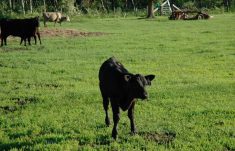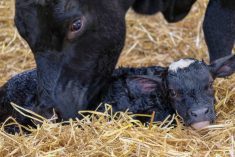Many commercial cattle minerals can be fed on a free-choice basis to gestating beef cows until calving. But even the best of these products fail if cows don’t eat enough, or engorge themselves.
Mineral intake problems must be corrected quickly so cows can either maintain or build a mineral (and vitamin) status which contributes to a problem-free calving season and beyond. But such success requires two things:
1. A mineral that the cow herd will readily consume to its recommended daily intake, and
Read Also

Gentle treatments for pain in the neck
Heading toward year-end, people unknowingly tense up against the cold and busyness, causing neck pain that can often be treated with appropriate support and gentle mobility, athletic therapist Kathlyn Hossack says.
2. Good mineral management once it is poured into mineral feeders.
The general recommendation to meet overwintering and gestating beef cows’ requirements on a free-choice basis is to feed about 100 grams (3.5 oz.) of salt-free mineral per cow per day. If salt makes up at least 25 per cent of this mineral formula, one should adjust this accordingly.
As a beef nutritionist, I don’t believe that beef cows actually seek to eat this exact amount of mineral to satisfy specific or multiple mineral/vitamin deficiencies. I do think cattle tend to exhibit abnormal behaviours such as chewing on bones (phosphorus deficiency), which tend to stop when they start to eat P-containing mineral. Yes, cattle also crave salt, but they often consume it way past any sodium requirement. In the end, my experience is that 100 grams is a man-made yet nutritious mineral pack than can be incorporated into many feeding programs.
This mineral target varies among cattle herds for different reasons, but university field trials prove that cattle tend to follow the same intake pattern — when daily mineral intakes are recorded and plotted against individual cows, the resulting graph takes the shape of a church bell. This means that more than two-thirds of the cow herd consume about the targeted amount of mineral. A small fraction often eats significantly less than desired, while a small number eat more than their fair share.
My only concern is that the lower-end cows will not meet their total mineral and vitamin requirements. Plus, neither individuals nor the whole cow herd are likely to consume the same amount of mineral every day. The intake target of 100 grams is based upon averaging daily intakes over significant periods, such as weekly, bi-weekly or longer.
Management is important
This is why good complementary management is needed to achieve consistent and targeted mineral intakes. For example, for the last few years I have worked with a 150-cow beef producer who feeds a well-balanced mineral that targets 100 grams per head per day until calving in late February. Her overwinter mineral management uses:
- Mineral complementing an all-forage diet: A 2:1 fortified “breeder” mineral (not salt) is specifically designed to be fed with high grass-type baleage, supplemented on occasion with extra limestone (a calcium source). Salt blocks are also provided.
- Durable plastic feeders: A few years ago, this producer mounted five new mineral feeders on tractor tires (one per 30 beef cows). These are spread on overwintering pastures, with one or two placed near heated waterers where the cattle congregate. Luckily, this farm has good-quality drinking water which doesn’t affect general mineral consumption.
- Calculated mineral intakes: Since mineral is put out every four days, the producer calculates the correct number of bags as:
1. 150 cows x 100 g = 15 kg
2. 15 x 4 days = 60 kg.
3. Each bag = 25 kg.
4. Need 60/25 = 2 ½ bags.
5. Put out three bags.
Late-autumn free-choice mineral consumption of her cow herd started off well at a quite-consistent 100-120 grams per head daily. A few years ago, things were not so rosy when monensin sodium was added at 2200 mg/kg to control bloat. This caused a major palatability issue and the cows would not touch it. Good mineral intake improved when the ionophore was removed and more DDGS added in its place.
Her testimonial demonstrates that good free-choice mineral nutrition and management come together to assure that the pregnant cows meet their nutrient requirements until calving. This same producer told me that some of her neighbours cannot get their cattle to eat loose mineral in the same satisfactory fashion. Many have resorted to other avenues of getting adequate mineral intakes such as force feeding into overwinter TMRs.
















